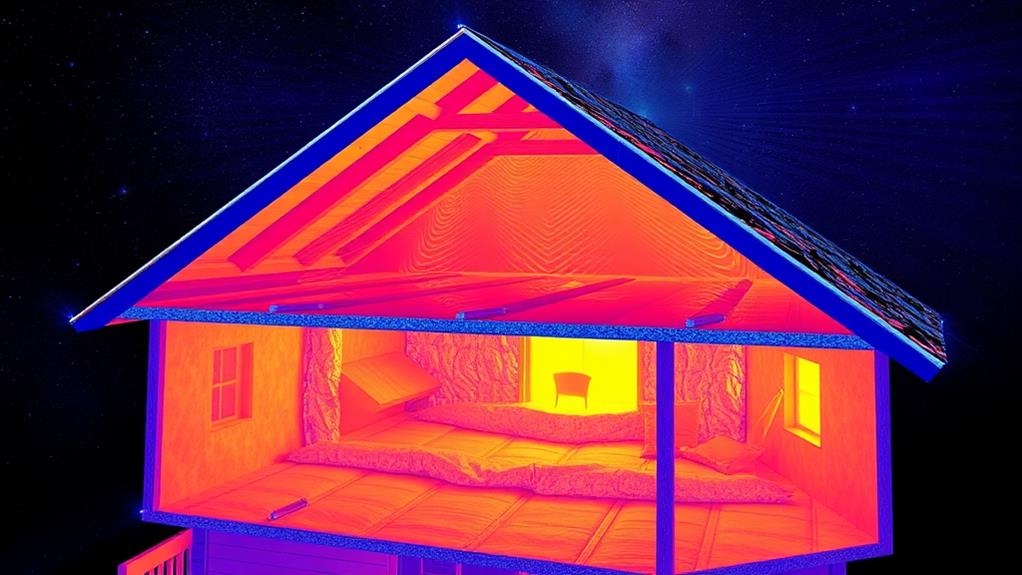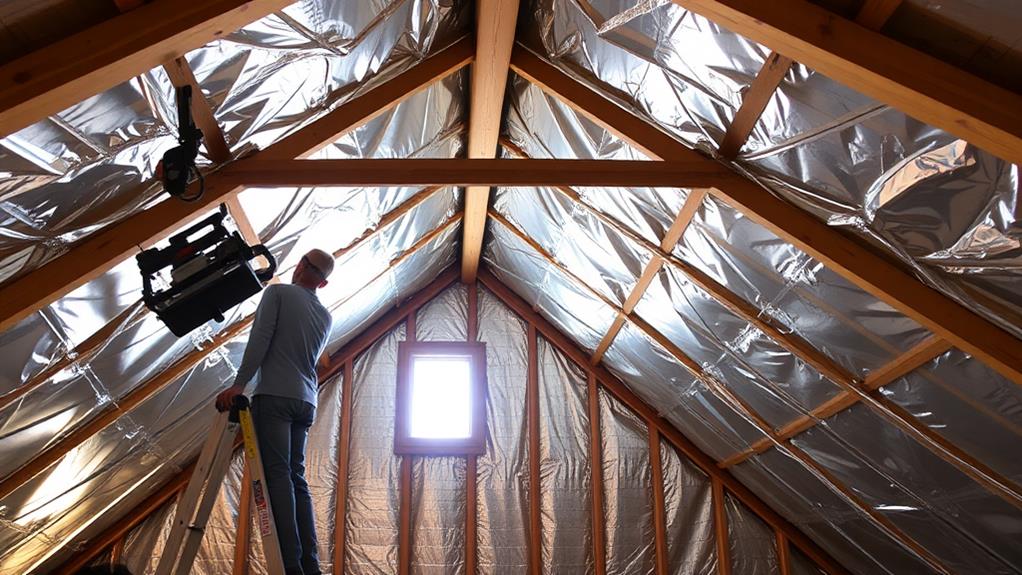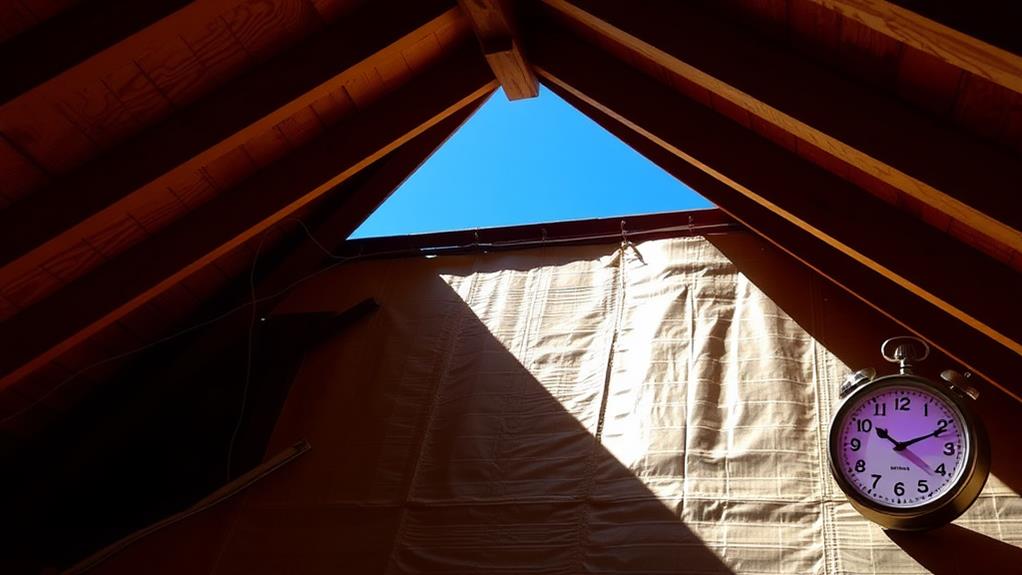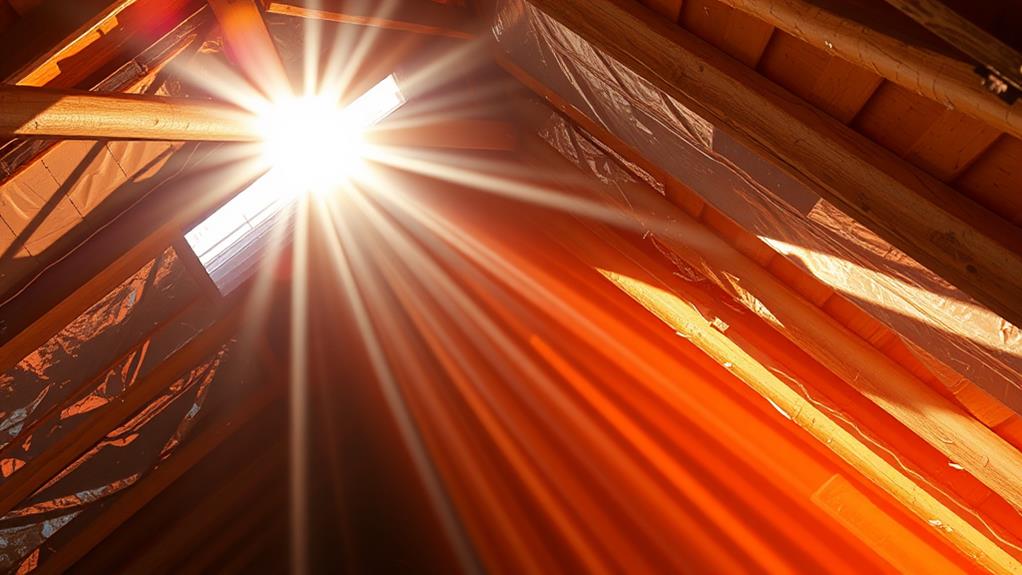Radiant barriers can be a worthwhile investment, especially if you live in a hot, sunny climate. They reflect up to 97% of radiant heat, potentially reducing your cooling costs by 5-10%. While installation costs vary, ranging from $0.50 to $1.50 per square foot for professional installation, the long-term benefits often outweigh the initial expense. These barriers are durable, lasting as long as your home with minimal maintenance. However, their effectiveness depends on factors like your local climate, home design, and existing insulation. To determine if radiant barriers are right for you, consider your specific circumstances and potential energy savings.
Understanding Radiant Barrier Technology

Radiant barrier technology is a simple yet effective method for managing heat transfer in buildings. It works by reflecting radiant heat rather than absorbing it, helping to keep your home cooler in summer and warmer in winter. You'll typically find radiant barriers made of highly reflective materials like aluminum foil, which is attached to a backing such as kraft paper or plastic film.
When installed properly, radiant barriers can reflect up to 97% of radiant heat. They're most effective in hot climates, where they can significantly reduce cooling costs by preventing heat from entering your home through the roof. In colder regions, they can help retain heat by reflecting it back into your living spaces.
You'll often see radiant barriers installed in attics, where they can be stapled to the underside of roof rafters or laid over existing insulation. They can also be incorporated into walls and floors. It's important to note that radiant barriers don't reduce conductive or convective heat transfer, so they're usually used in conjunction with traditional insulation for optimal energy efficiency.
Energy Savings Potential
The potential for energy savings with radiant barriers can be substantial, depending on your specific climate and home construction. In hot climates, where cooling costs dominate, you'll see the most significant benefits. Radiant barriers can reduce cooling costs by 5-10% in warm, sunny regions. They're particularly effective in homes with air-conditioned spaces directly below the roof, such as those with attic HVAC systems.
You'll notice less impact in cooler climates, where heating is the primary concern. However, radiant barriers can still help by reflecting heat back into your living spaces during winter. The energy savings will vary based on factors like your roof's solar reflectance, attic insulation levels, and local energy prices.
To maximize your energy savings, combine radiant barriers with proper attic ventilation and insulation. This comprehensive approach can lead to enhanced comfort and reduced utility bills. Remember, while radiant barriers can be effective, they're not a substitute for traditional insulation. They work best as part of a holistic energy-efficiency strategy tailored to your home's specific needs and your local climate conditions.
Installation Costs and Considerations

Cost considerations for radiant barrier installation can vary widely depending on several factors. You'll need to account for the size of your attic, the type of radiant barrier you choose, and whether you opt for professional installation or a DIY approach. Professional installation typically ranges from $0.50 to $1.50 per square foot, while DIY materials can cost $0.10 to $0.30 per square foot.
If you're handy, you can save money by installing the radiant barrier yourself. However, it's crucial to consider safety precautions, as working in attics can be dangerous. You'll need proper safety equipment and knowledge of how to navigate around electrical wiring and insulation.
When planning your installation, you'll need to decide between foil-faced materials or spray-on applications. Foil-faced options are generally less expensive but can be trickier to install properly. Spray-on applications offer more uniform coverage but come at a higher cost.
Don't forget to factor in additional costs such as staples, tape, or specialized tools you might need for the installation process. It's also wise to consider any necessary attic preparation work, like removing old insulation or addressing ventilation issues, before proceeding with the radiant barrier installation.
Climate and Regional Effectiveness
Across different regions, the effectiveness of radiant barriers can vary significantly. In hot, sunny climates like the southern United States, you'll see the most benefit from radiant barriers. These areas experience intense solar radiation, which can significantly heat up attic spaces. By reflecting this heat, radiant barriers can reduce cooling costs by up to 10%.
However, if you live in a cooler climate, you mightn't reap the same rewards. In northern regions, where heating is a primary concern, radiant barriers aren't as effective. They can't prevent heat loss during winter months, so your energy savings will be minimal.
Consider your local weather patterns too. Areas with high humidity may see reduced effectiveness, as moisture can compromise the barrier's reflective properties. You'll also want to factor in your home's design. Houses with dark roofs or poor attic ventilation will benefit more from radiant barriers than those with light-colored roofs or well-ventilated attics.
Ultimately, your location plays a crucial role in determining whether a radiant barrier is a worthwhile investment. Consult local energy experts to get region-specific advice before making a decision.
Long-Term Benefits and Durability

Investing in radiant barriers can yield long-lasting benefits for homeowners. When properly installed, these barriers can maintain their effectiveness for decades, often lasting as long as the home itself. You'll find that quality radiant barriers don't degrade or lose their reflective properties over time, ensuring consistent performance year after year.
The durability of radiant barriers is impressive. They're resistant to moisture, mold, and pests, which means you won't need to worry about frequent replacements or repairs. This longevity translates to sustained energy savings throughout the life of your home. You'll continue to benefit from reduced heat gain in summer and heat loss in winter, potentially lowering your energy bills for years to come.
Moreover, radiant barriers require little to no maintenance. Once installed, you can essentially forget about them while they silently work to improve your home's energy efficiency. This hands-off approach makes them an attractive option for homeowners looking for long-term solutions without ongoing upkeep. When you consider the cumulative energy savings and increased comfort over many years, the initial investment in radiant barriers often proves to be a wise financial decision.
Alternatives to Radiant Barriers
While radiant barriers offer impressive benefits, they're not the only solution for improving your home's energy efficiency. You have several alternatives to consider that can help reduce heat gain and lower energy costs.
One popular option is traditional insulation materials like fiberglass, cellulose, or spray foam. These products work by slowing heat transfer through conduction and convection, rather than radiation. You can install them in your attic, walls, and floors to create a more comprehensive thermal barrier.
Another alternative is cool roofing materials. These include reflective shingles, tiles, or coatings that reflect sunlight and absorb less heat than standard roofing materials. They're particularly effective in hot climates and can significantly reduce your cooling costs.
You might also consider installing attic fans or vents to improve air circulation and reduce heat buildup. This can help lower attic temperatures and decrease the strain on your air conditioning system.
Energy-efficient windows with low-E coatings can block solar heat while allowing visible light to pass through. They're an excellent choice for reducing heat gain without sacrificing natural light.
Lastly, strategically planted shade trees or exterior awnings can provide natural cooling by blocking direct sunlight from entering your home.
Conclusion
You've now explored the world of radiant barriers, from their futuristic technology to their potential for slashing your energy bills. While they're not a silver bullet for every home, in the right climate, they can be worth their weight in gold. Consider your location, installation costs, and long-term benefits before deciding. Remember, there's no one-size-fits-all solution, so weigh your options carefully. You're now armed with knowledge to make the best choice for your home.

